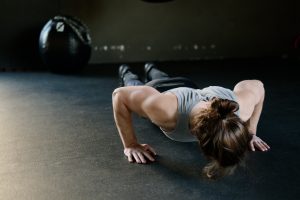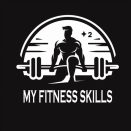Introduction to push ups
Push ups are a calisthenics exercise performed by lowering and raising the body using the arms, primarily the chest, shoulders, and triceps, to push the body off the ground.
Basic Technique:
- Starting Position: Begin in a plank position with hands slightly wider than shoulder-width apart, arms fully extended, and feet together.
- Execution: Lower the body by bending the elbows until the chest nearly touches the ground or reaches a comfortable depth. Maintain a straight line from head to heels throughout the movement.
- Return to Start: Push through the hands to extend the arms and return to the starting position, fully extending the elbows.
Variations of push ups
Push ups can be modified or varied to target different muscles and accommodate various fitness levels:
- Standard Push-Up: Feet together, hands slightly wider than shoulder-width.
- Wide-Grip Push-Up: Hands positioned wider than shoulder-width, emphasizing the chest.
- Close-Grip Push-Up: Hands close together, emphasizing the triceps.
- Decline Push-Up: Feet elevated, increasing the intensity on the upper chest and shoulders.
- Incline Push-Up: Hands elevated, targeting the lower chest and reducing overall body weight.
- Diamond Push-Up: Hands close together in a diamond or triangle shape, focusing on the triceps and inner chest.
- One-Arm Push-Up: Advanced variation, performed with one hand, challenging stability and strength.
- Plyometric Push-Up: Incorporates an explosive push-off, enhancing power and muscle activation.
- Clapping Push-Up: Involves clapping the hands together at the top of the movement, emphasizing explosive power.
Considerations:
- Proper Form: Maintaining proper form is crucial to prevent injuries and effectively target the intended muscles.
- Progression: Beginners should start with easier variations and gradually progress to more challenging variations as strength improves.
- Incorporation into Routine: Push ups can be incorporated into a full-body workout routine or as part of a specific chest or upper body workout.
Benefit of push ups exercise
Push ups are a versatile and effective bodyweight exercise that offers a multitude of benefits for overall fitness and strength development. Here are some key benefits of incorporating push ups into your workout routine:
Muscular Strength and Development:
- Chest: Push ups primarily target the pectoral muscles (chest), helping to build strength and muscle mass in this area.
- Shoulders: The anterior deltoids (front shoulder muscles) are also engaged during push ups, contributing to shoulder strength and development.
- Triceps: Push ups effectively work the triceps, located at the back of the upper arm, aiding in overall arm strength.
Core Engagement and Stability:
- Core Muscles: Push ups engage the entire core region, including the rectus abdominis, obliques, and lower back muscles, promoting core stability and strength.
- Postural Benefits: Strengthening the core through push ups can contribute to improved posture and spinal alignment.
Functional Strength and Endurance:
- Pushing Power: Push ups enhance pushing strength, which is essential for various daily activities, such as pushing doors, furniture, or lifting objects.
- Upper Body Endurance: Regularly performing push ups can improve muscular endurance in the chest, shoulders, and triceps, allowing you to perform more repetitions or sustain activities requiring upper body strength for longer durations.
Flexibility and Range of Motion:
- Shoulder Flexibility: The dynamic movement of push ups helps maintain and improve shoulder flexibility, promoting a healthy range of motion in the upper body.
- Joint Health: Engaging in push ups can help maintain the health and mobility of the shoulder joints, reducing the risk of stiffness or imbalances.
Convenience and Versatility:
- No Equipment Needed: Push ups require minimal to no equipment, making them accessible and convenient for workouts anywhere, anytime.
- Variety of Variations: There are numerous push-up variations that can be tailored to individual fitness levels and goals, allowing for progression and continued challenge.
Mental and Overall Well-being:
- Mental Focus: Performing push ups requires concentration and focus on proper form, promoting mindfulness and mental clarity during exercise.
- Overall Fitness: Incorporating push ups into a comprehensive fitness routine can contribute to improved overall fitness, including cardiovascular health, muscular endurance, and body composition.
Types of push ups exercise
Push ups can be varied and modified in numerous ways to target different muscles, increase or decrease intensity, and accommodate various fitness levels. Here are several types of push-up exercises:
Basic Push-Up Variations:
- Standard Push-Up:
- Hands slightly wider than shoulder-width apart, feet together, maintaining a straight body position.
- Wide-Grip Push-Up:
- Hands positioned wider than shoulder-width, emphasizing the chest muscles.
- Close-Grip Push-Up:
- Hands close together, focusing on the triceps and inner chest.
- Decline Push-Up:
- Feet elevated on a bench or platform, increasing the emphasis on the upper chest and shoulders.
- Incline Push-Up:
- Hands elevated on a bench or platform, targeting the lower chest and reducing overall body weight.
- Diamond Push-Up:
- Hands close together in a diamond or triangle shape beneath the chest, intensifying the focus on the triceps.
Advanced and Specialized Push-Up Variations:
- One-Arm Push-Up:
- Advanced variation performed with one hand, challenging stability and strength.
- Plyometric Push-Up:
- Incorporates an explosive push-off, emphasizing power and muscle activation.
- Clapping Push-Up:
- Involves clapping the hands together at the top of the movement, further enhancing explosive power.
- Spiderman Push-Up:
- As you lower your body, you simultaneously bring one knee toward the elbow on the same side, emphasizing core and oblique engagement.
- T-Push-Up:
- After each push-up, rotate the body to one side, extending the arm upward toward the ceiling, engaging the shoulders and core.
- Handstand Push-Up:
- Advanced variation performed in a handstand position against a wall, targeting the shoulders and requiring significant strength and balance.
- Staggered Push-Up:
- One hand positioned slightly forward and the other slightly back, alternating between sides, challenging stability and emphasizing different muscle activation.
- Elevated Feet Push-Up:
- Feet elevated on a higher surface than the hands, intensifying the focus on the upper chest, shoulders, and core.
Modified and Beginner Variations:
- Knee Push-Up:
- Perform push-ups with knees on the ground, reducing overall body weight and making it more accessible for beginners.
- Wall Push-Up:
- Standing and facing a wall, perform push-ups against the wall, gradually progressing to floor-based push-ups.
These variations offer a range of options to tailor push-up exercises to individual fitness levels, goals, and specific muscle targeting. Incorporating a variety of push-up variations into your workout routine can help you continuously challenge and progress your strength and fitness levels.
Tips for Maximizing Push-Up Benefits
- Consistency: Incorporate push-ups into your regular workout routine, ensuring consistency to see improvements in strength and endurance.
- Proper Form: Focus on maintaining proper form throughout each repetition to effectively target the intended muscle groups and reduce the risk of injury.
- Variety: Explore different push-up variations to challenge various muscle groups, prevent boredom, and promote continuous progress.
- Rest and Recovery: Allow adequate rest between push-up sessions to facilitate muscle recovery and prevent overtraining.
- Nutrition: Ensure a balanced diet rich in protein and nutrients to support muscle growth, repair, and overall fitness goals.
Real-Life Testimonials
“I incorporated push-ups into my daily routine, starting with modified versions. Over time, I progressed to standard push-ups and eventually advanced variations. Not only have I noticed significant improvements in my upper body strength, but my overall fitness level has also improved.” – Alex, Fitness Enthusiast
“Push-ups have been a game-changer for me. They’re convenient, effective, and versatile. I’ve tried various variations and love how they target different muscle groups. Plus, I can do them anytime, anywhere!” – Sarah, Busy Professional
Conclusion
Push-ups are a timeless, effective exercise that offers a multitude of benefits for individuals of all fitness levels. By mastering the correct technique, incorporating a variety of variations, and maintaining consistency, you can harness the full potential of push-ups to enhance strength, endurance, and overall fitness. Embrace the push-up as a staple exercise in your fitness regimen and embark on a journey to a stronger, healthier you.
NEXT –CHEST

Dating is a truly joyful experience. Sometimes we lose sight of this truth in our search for the right Online dating site
Hey there just wantedd to give you a quick heads
up. The text in your post seem to be runmning off the
screen in Ie. I’m not sure if this is a format issue or something to do with internet browser compatbility but I thought
I’d post to let you know. Thee design and style lolok great though!
Hope you get the issue resolved soon. Thanks https://www.waste-ndc.pro/community/profile/tressa79906983/
ok i’ll fix it soon
This post gives clear ide designed for the new people of
blogging, that really how to do blogging. https://Www.Waste-Ndc.pro/community/profile/tressa79906983/